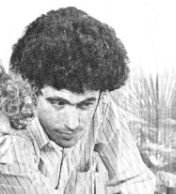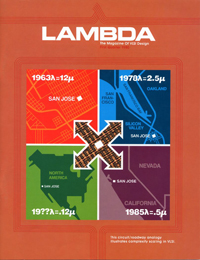 Doug Fairbairn was at Xerox PARC (along with Lynn Conway of Mead & Conway fame) when the VLSI design revolution began. He would go on to be one of the founders of VLSI Technology but he also realized that every revolution needs its printing press and so he created Lambda magazine. This is the first of two entries telling that story.
Doug Fairbairn was at Xerox PARC (along with Lynn Conway of Mead & Conway fame) when the VLSI design revolution began. He would go on to be one of the founders of VLSI Technology but he also realized that every revolution needs its printing press and so he created Lambda magazine. This is the first of two entries telling that story.
On a personal note, Doug hired me from Scotland to come and join his development team at VLSI Technology. I originally intended to come for a couple of years (this was 1982); I’m still here.
Click here for a pdf of the first issue of Lambda.
LAMBDA Fostered Structured Design Revolution
Today there would be websites, blogs, twitters, email blasts, etc., but in the late summer of 1979, when it came time to build a community around the rapidly expanding Mead-Conway Design Methodology, we didn’t have those options. OK, we had email to ARPAnet sites, but that was it. Text only, no graphics, with limited access. So what to do?
Along with several others at Xerox Palo Alto Research Center (PARC) and Caltech in Pasadena, we conceived the idea of a magazine focused on this new approach to IC design. We needed to reach a whole new community of designers—engineers who were interested in taking a systems approach to IC design…mapping architectures to silicon…silicon compilers….new types of design automation. There were lots of new ideas, articles to write, and excitement to share. Working through the mainstream publications was just not going to work.
 It probably seems shocking to most that we could formulate an idea and make plans to publish a magazine on a new design methodology from the confines of an industrial research lab. But for those of us at Xerox PARC, it was just a natural extension of what we were already doing. The lab had been in operation for eight or so years by then and its research focus was almost entirely internally directed. Whatever we thought was a good idea was what got done. That philosophy, combined with some of world’s best computer scientists, engineers, physicists and other researchers had already created the first personal workstation, Ethernet, laser printers, the optical mouse and many other building blocks of the personal computer revolution to come.
It probably seems shocking to most that we could formulate an idea and make plans to publish a magazine on a new design methodology from the confines of an industrial research lab. But for those of us at Xerox PARC, it was just a natural extension of what we were already doing. The lab had been in operation for eight or so years by then and its research focus was almost entirely internally directed. Whatever we thought was a good idea was what got done. That philosophy, combined with some of world’s best computer scientists, engineers, physicists and other researchers had already created the first personal workstation, Ethernet, laser printers, the optical mouse and many other building blocks of the personal computer revolution to come.
In fact it was this strong expertise in document creation and publishing that made the idea of a magazine seem downright reasonable. We found a Xerox group in Pasadena CA who had interfaced an optical typesetting machine to PARC’s Alto personal computer. They saw the new magazine as a way to work out the kinks and prove the value of computer-based typesetting. They agreed to help with the logistics, and most importantly pay for the layout and printing of the first four issues of LAMBDA.
I did clear the project with our lab director, Bert Sutherland, and figured with his approval I didn’t need to seek any further permission. Even at PARC, I knew if you asked enough people, there were certainly some who would find it outside our mission! As I remember, he had only one serious question: “What would I do after the first four quarterly issues?”. My response was practical, “If it is a roaring success, I’ll know what to do. If it’s a dismal failure, I’ll know what to do. If it’s somewhere in between, I’ll have to decide.” With that we were off and running.
The next step was content…starting with the cover. Given the title of LAMBDA (the scaling unit in the Mead/Conway design methodology), it was an easy choice to use the Chuck Seitz analogy comparing the network of interconnect with the grid of roads which made up a typical city. The cover showed four different scales for LAMDA from LAMBDA=12μ to Lambda=0.12μ. At the time LAMBDA was first published lambda values were approximately 2.5μ, implying minimum lines and spaces of 5μ. Moore’s law was well-recognized at the time, and we knew that dimensions would shrink well below a micron before scaling was done. In fact, the cover art envisioned lines and spaces of approximately 0.5μ. Today we are well beyond that – with lines and spaces less than 0.05μ! This implies 100x greater density than that envisioned on this early cover.
Note that even at 0.5μ dimensions, the complexity of an integrated circuit would be equivalent to covering the North American continent with streets at an urban density…. and we are 100x beyond that in today’s systems-on-chip. Our vision only went so far!
The magazine opened with a letter “from the editors”. We boldly forecasted that “In the near future we will see a radical upgrading of design aids”, a need “to develop new design methodologies… “ and “to turn our attention to higher level optimizations”. These seem obvious now, but at the time the universal focus on optimizing silicon area at all costs was still strongly in place, and would remain so for nearly a decade. We closed the editorial comments with the following paragraph:
“When design activity is localized within small groups in a few companies, formal communications mechanisms such as magazines are not appropriate. Now that integrated circuit design has broken those bounds and is actively practiced by a large number of people in diverse companies and universities, we feel that a magazine devoted strictly to their needs is required. LAMBDA is that magazine.”
The remainder of this first 32-page issue contained various news items, an update on university activities, and four feature articles on “IC Fabrication for the Independent Chip Designer” by Robert Hon, “Ideas About Arbiters” by Prof. Charles Seitz of Caltech, “The Design of a 16 x 16 Multiplier” by Rodney Masumoto of TRW, and “VTI Bets on Custom” by yours truly.
This last article is of particular note, as it outlined the business plan of a company, VLSI Technology Inc, that planned to offer foundry services to the new design community at which LAMBDA was targeted. As fate would have it, I became the fourth founder of this new company, quitting Xerox to join the new firm on about the same day (January 8th, 1980) the first issue of LAMBDA hit the streets.
Credits: As with any great (ad)venture, this magazine was the work of many. I am particularly grateful for the support and nurturance provided by two people. First is Lynn Conway of Xerox PARC, without whom there would have been no book, no design revolution, and no magazine. Second to my long-time business partner and supporter, Jim Rowson. At the time the magazine was launched, Jim was at Caltech in Pasadena and a former consultant at PARC. He shared the load in launching the magazine, soliciting and editing articles, inputting text, sticking on mailing labels…whatever it took. For his wisdom, hard work, and support, I am eternally grateful.
